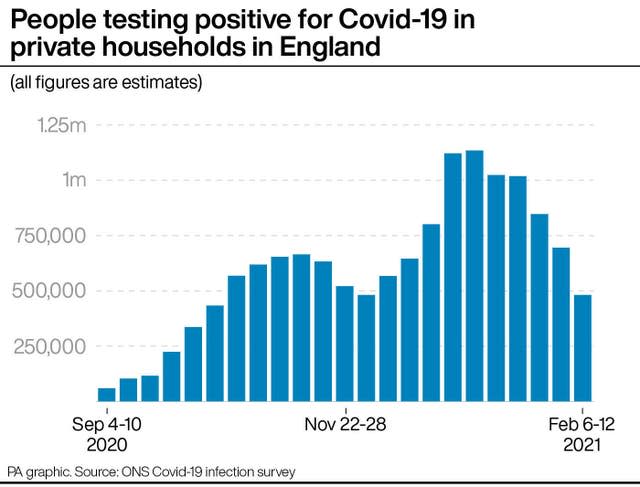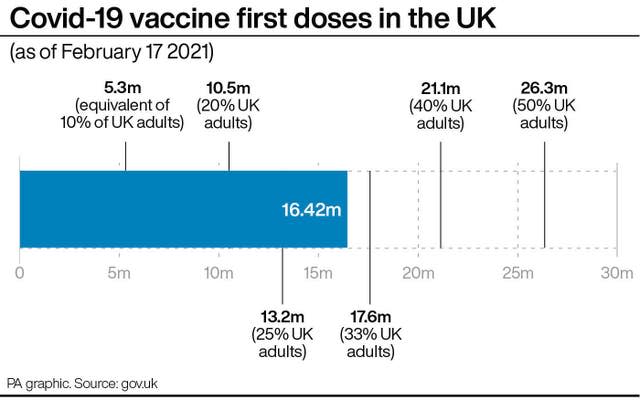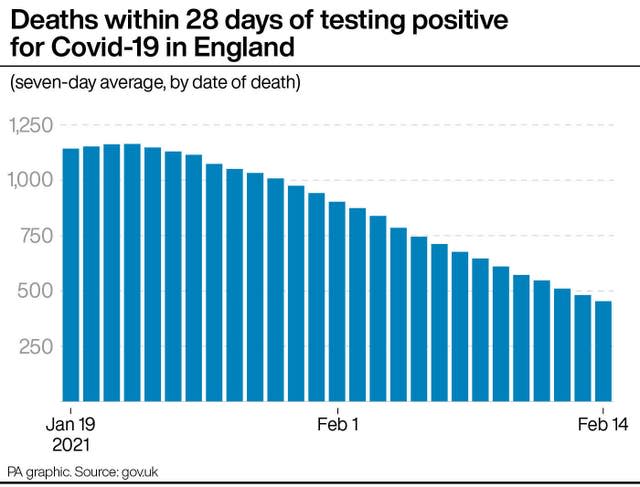UK infections drop as study backs long interval between AstraZeneca jab doses
Coronavirus infections are dropping across the UK, new data suggests, as a study found that giving doses of the Oxford/AstraZeneca vaccine 12 weeks apart improves protection.
Around one in 115 people in private households in England had Covid-19 between February 6 and 12, the Office for National Statistics (ONS) said, down from around one in 80 people from January 31 to February 6.
Meanwhile, in Wales, around one in 125 people are estimated to have had Covid-19 between February 6 and 12, down from one in 85 previously.
In Northern Ireland, the figure is around one in 105 people, down from one in 75, while in Scotland it is around one in 180 people, down from one in 150.
The data, which does not cover care homes and hospitals, is based on swab tests from thousands of people regardless of whether or not they have symptoms.
It comes as new analysis from Oxford University published in The Lancet confirmed that a single dose of the AstraZeneca vaccine offers 76% protection against Covid-19 from 22 days after vaccination, and that this had not waned by the three-month mark.
The UK policy of leaving up to 12 weeks between doses also resulted in a higher efficacy overall, the study found.
There was 81% protection when three months was left between the two doses, compared to 55% for up to a six-week interval.
The Oxford team is still urging people to have two doses of the vaccine because they say it is not yet clear how long protection with a single dose may last.

Meanwhile, Government scientists put the R – the number of people an infected person will pass coronavirus on to – at 0.6 to 0.9 for the UK, compared to 0.7 to 0.9 in the previous week.
The lower end estimate is at its lowest point recorded by the scientists, and the R is below 1 in all regions of England.
However, the experts warned that “prevalence of the virus remains high, so it remains vital that everyone continues to stay at home in order to keep the R value down”.
Earlier, top scientific advisers said vaccines were having an impact on the pandemic, as Prime Minister Boris Johnson prepares to publish his road map out of lockdown on Monday.
Professor Adam Finn, from the University of Bristol and a member of the Joint Committee on Vaccination and Immunisation (JCVI), said “everything’s moving in the right direction” when it comes to how jabs are working.

He told BBC Radio 4’s Today programme: “We’ve now got to the point with the study we’re doing in Bristol where we can say with certainty that there is definitely an effect.
“It’s just hard to put an exact number on it at this point because… the numbers of cases coming through are still building up, the number of people who’ve been vaccinated are still going up, but it’s becoming clearer for the Pfizer vaccine, which we’ve been using for a month longer, since early December, and it’ll take slightly longer for us to get a firm handle on just how well the AstraZeneca vaccine is preventing hospitalisations too, but they’re definitely doing the job.”
Professor Neil Ferguson, from Imperial College London, said the data on vaccine effectiveness and how quickly infection, deaths and hospital cases were declining across the country was looking promising.
He said he thought the current lockdown should be lifted in stages, adding:”I am encouraged by the cautious approach being taken, an incremental approach which I think will be adopted, namely relax one thing and see what the impact is, relax again.
“And it still may well be that by the end of May, we’re in a very different country than we are today.”

Figures show a continued decline since Christmas in the number of new cases of coronavirus, although rates vary according to region.
Overall, 74,961 new cases were recorded in England in the seven days to February 14, the equivalent of 133.2 per 100,000 people.
This is down sharply from a peak of 680.8 cases per 100,000 people on January 4.
It is also the lowest seven-day rate since October 4.
Meanwhile, the number of patients in hospital in England with Covid-19 has also fallen sharply in recent weeks.

A total of 15,633 patients were in hospital as of 8am on February 18, down 54% from a record 34,336 patients exactly one month earlier.
But while this is a sizeable drop, numbers at both a national and regional level are still higher than when England came out of its second lockdown on December 2.
All regions also continue to report patient numbers well above those seen last May, when Boris Johnson announced the initial easing of the first lockdown.
Meanwhile the number of daily hospital admissions of patients with Covid-19 stood at 1,311 on February 16, down 68% from a peak of 4,134 on January 12, but still above the 1,262 on the day England came out of its second lockdown on December 2.

A further 533 people had died within 28 days of testing positive for Covid-19 as of Friday, bringing the UK total to 119,920, and there had been another 12,027 lab-confirmed cases of coronavirus, increasing the UK total to 4,095,269.
In other developments:
– Foreign Office minister James Cleverly said it would be wrong for him to speculate on whether summer holidays will go ahead.
– Data from the Zoe app study from King’s College London suggests a 5% drop in symptomatic cases of Covid in the UK on average in the most recent week.
– Mayor of London Sadiq Khan received his first dose of the Covid-19 vaccine, with his asthma putting him in a priority group. He told the PA news agency there should be no return to the tier system for managing coronavirus.
Elsewhere, Wales’ First Minister Mark Drakeford has said some aspects of non-essential retail, as well as personal services such as hairdressing, could begin to reopen there from March 15, with stay-at-home restrictions eased in three weeks.
All primary school children in Wales are expected to return to face-to-face teaching from mid-March, while the number of people allowed to exercise together will increase from two to four.


